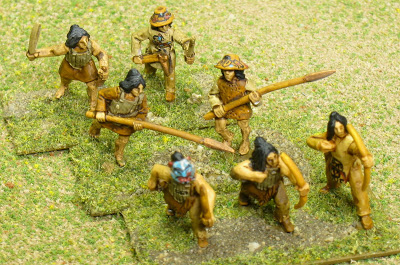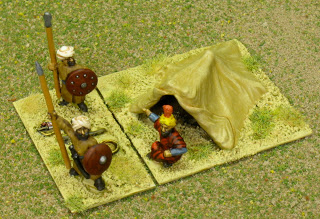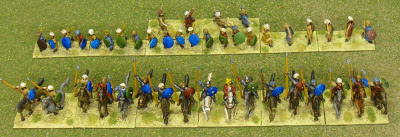I followed my DBA plans quite closely. I’ll describe my overall impressions first, with my personal results later so I’ll remember them (but not because I think anyone else cares).
I definitely enjoyed playing DBA at Historicon. The last time I went to an HMGS convention I was alone, and decided it wasn’t fun enough for me to go again without a travelling companion; but I was only playing GM’d games and not DBA. This time, I played DBA with folks I’ve met online, and some I’ve played with in person, and it made the convention a lot more enjoyable. I definitely plan to attend more cons just for the DBA, and I’ll be more likely than I was this time to dedicate an entire day to BBDBA doubles or other longer tournaments.
It was good to finally associate faces and personalities to their online counterparts. I think this is important to provide context for interpreting peoples’ forum posts (especially all the taunting). I was as shy as I usually am in person, but opened up somewhat as the weekend progressed.
I really enjoyed playing against new opponents and against armies I’ve never faced or even seen before. The themes helped with this. In particular, the Assyrian Dominance and Fall theme increased my interest in book I armies significantly.
My goal for the convention was to win one game in every tournament except Midnite Madness, which I would lose so I could get to bed earlier. I won the right number of games, but in the wrong events: I won the first round of Midnite Madness, but didn’t win any games in the Baltic Crusades event.
In the Splendor of Persia event, first round(s) were matched by army year as usual, resulting in several civil wars. My Arab Conquest army faced Tony Aguilar’s Arab Conquest, the four Ghaznavid players all fought each other for the first two rounds, and the Fatamid players duked it out. Tony beat me 4-2. In the next two rounds I lost to David Schlanger’s Fatamids, 5-2, and Ron Giampapa’s Fatamids, 2g-1. Finally, in the last round I pulled off a 4-1 win against Rob Torres and his Ghaznavids.
Immediately following the Persian event was Midnite Madness. I continued to use my Arab Conquest army, and beat Jim Kasper’s Thematic Byzantines in the first round, 4g-1. In the next round, David Bostwick beat me 5-1 with his Leidangs. This was the most interesting Viking-ish battle I’ve ever fought or seen. The Leidang light foot helped, and Leidang have a much lower aggression than Vikings. But he didn’t just deploy in a long line and walk forward. Vikings have options? Who knew.
On Friday, my only DBA event was the Assyrian Dominance and Fall theme. Unfortunately, the tournament only had 3 rounds, so I was unable to collect a full set of 4 Bostwicks. In the first round, I beat Jason Bostwick’s Early Bedouins with my Early Bedouins, 4-2. Next I lost 4-1 against David Bostwick’s Philistines: despite two or three rounds of combat with his general completely surrounded, I just couldn’t kill it, and he ended up totally turning the tables. Finally, I lost 1g-0 against Alex Bostwick’s Philistines in a very short game; but not the shortest. Someone else lost their general to a psiloi rush in the first or second turn in that round.
The first event on Saturday was Not The NICT: matched pairs for everyone who didn’t qualify for the championships. There were 6 of us, and we ended up playing 3 rounds to find a best player in the A and B groups. In the first round we used my armies. Mike Guth chose Early Bedouins against my Later Achaemenid Persians, and beat me 4-1. In the next round, I chose Alex Halkiadakis’s (“Greek Alex”) Hittite Empire (a) list against his Mitanni, and won 4-2. It was enjoyable to “test drive” this army since I have it unpainted in a box. I managed to repel his light foot in the woods successfully with my spears, with the help of some good die rolls. In the last round, Hank Drapalski chose to play Later Achaemenid Persians against my Bedouins, and beat me 4-3 in a close match. The tactical situation was very stressful for Hank, but I enjoyed the interesting battle.
I was afraid that bringing light foot armies to a matched pair would result in longer games that might have to be called due to time, but this was an incorrect assessment. Light foot vs. heavy foot can be slow due to all the posturing and maneuvering required to find good matchups and avoid bad ones. In an all-light-foot battle, face to face battles in open ground are viable and resolve much more quickly than spear lines with their higher combat factors. I enjoyed the maneuvering that happened in these battles.
My final event for the con was the Baltic Crusades theme campaign. I expect a full report of the campaign to be posted on the Fanaticus forum in due time, so I’ll give my impression of the rule changes that affected me, and summarize my games the best I can from memory.
The basic campaign rules work as I expected based on reading about other Two Davids campaigns. Each campaign round, players draw numbered tiles from a bag. Players act in ascending order, to choose where to attack. Attacker’s aggression is the distance moved plus one, and defender’s aggression is zero. You can move over battles but not over opponents who aren’t locked in battle yet.
There were a few rules that affected the Mongols. First, their aggression was 0 plus the number of regions moved instead of 1, to represent their superior scouting. This had only a minor effect on my games, since the attacker alway has higher aggression anyway. Mongols who won an attack (not a defensive combat) could move their home region, but that didn’t affect anyone in this tournament.
Finally, Mongols were allowed to flank march. This worked exactly as a littoral landing on a sea of grass, except you could only deploy to the sides, not the rear. It provided additional tactical options, but it was risky. On a 30″ board you were virtually guaranteed to be out of command radius if you made anything but a very conservative landing. The light horse can catch up with their multiple moves, if you get enough PIPs, but you’re definitely at risk on early turns until you roll high.
In the first round, I drew a high number but was still able to attack. I attacked Jim Kasper’s Russians, one of the few remaining targets. All I’ll say about this game is: always remember to deploy all twelve elements before you start the game. Oh yeah, also: a lot of the board can be outside command range on a 30″ board.
Next round, I was attacked by David Kuijt, playing Volga Bulgars. I placed terrain (not particularly well) and put up a good fight, but he beat me. I had a handle on command radius by then, but the whole tournament I was trying to figure out what to do with my artillery. I was able to get a few shots off, but mostly it got in my way a lot. After the game, DK showed me a better terrain deployment for my situation: if I had placed one central piece of bad going, it would provide only one place for his bows to hide. That gives me one obvious target for my artillery, which makes it easier to know where to point it.
In the third round, I faced David Schlanger’s Russians; I don’t remember whether I attacked or not. This was my first attempt at a flank march, and it almost worked really well. He didn’t deploy to counter it, and ended up moving a huge force to face the threat to his flank. This ate a lot of PIPs, and although a few of my light horse died, the rest was able to retreat with multiple moves when he was at his weakest. This allowed my main force to attack frontally, and I almost beat him. It was a tight 3-3 bout that hinged on very few die rolls, but eventually he took my general and won. I really enjoyed that game, and again, I learned a lot.
My final match was against David Bostwick’s Cumans: he had even more light horse than me. He deployed to counter a flank march, but I attempted one anyway. It didn’t work out as well, but I was able to retreat without significant losses. In that situation in the future, I think it would’ve been better to skip the flank attack and swarm him frontally, hoping he couldn’t redeploy his flanks in time. I remember this also being a fairly close match, but I may not be remembering correctly.
In the end, I got no points for winning games or any other bonus VP, but I lost one for losing my general. I ended up in last place, the only player with a negative score. Oh well, better luck next time. Overall, the campaign was dominated by the stronger Western armies, but I never faced any of them so I have no good reason to have lost so much.
I had a great time at Historicon. My sincere thanks go to the event coordinators for organizing these events, and to my opponents for teaching me valuable lessons. I definitely hope to go to more HMGS cons in the future, and to eventually start winning a few more games.
 Almost all of the helmets and armor patterns are taken directly from specific images I found online. Some of the helmets are patterned after modern helmets carved and painted by Tommy Joseph: specifically, his Wolf War Helmet and a human helmet whose images I can’t find anymore.
Almost all of the helmets and armor patterns are taken directly from specific images I found online. Some of the helmets are patterned after modern helmets carved and painted by Tommy Joseph: specifically, his Wolf War Helmet and a human helmet whose images I can’t find anymore. 



















